A Dynamic Assessment of Digital Maturity in Industrial SMEs: An Adaptive AHP-Based Digital Maturity Model (DMM)with Customizable Weighting and Multidimensional Classification (DAMA-AHP)
Abstract
1. Introduction
2. Systematic Literature Review (SLR)
2.1. Digital Transformation Indices (DTIs)
2.2. Digital Maturity Models (DMM)
2.3. Digital Maturity Models (DMM) for SMEs
2.4. Digital Maturity in the Balkan Region
3. Methodology and Methods
3.1. Definition of the Conceptual DMM
- Complete comprehensibility for the user in both descriptions and calculations of the DMM;
- A set of dimensions corresponding to the current state of digital maturity in Croatia and the Balkan region;
- Maturity levels adapted to the regional digital maturity landscape;
- The number and content of elements per dimension correlated with the findings from the literature and the current maturity levels;
- The total number of dimension items limited to 70 to ensure that the assessments could be completed within 90 min;
- Simple determination of the importance of the dimensions using a multi-criteria decision making method (MCDM);
- Possibility to assign differentiated importance to items within a dimension;
- Easy scalability, allowing the addition of new dimensions and items;
- Use of commonly available tools (MS Office) in the initial development phase;
- Potential for future upgrades to a web-based interface.
3.2. Comparative Analysis with Existing DMM
4. Results
4.1. Determination of Dimension Weights
4.2. Definition of the Extended Maturity Assessment Model
4.3. Workflow for the Application of the DAMA-AHP Model
- Determining the weighting values for individual dimensions of digital maturity;
- Assessing the maturity level of the individual DT elements;
- Adjusting the desired maturity level for each DT element;
- Adjusting the weighting values for the individual DT elements.
5. Model Validation Through a Case Study
5.1. Model DAM-AHP Validation
5.2. Limitations and Future Directions
5.3. Discussion
6. Conclusions
Author Contributions
Funding
Institutional Review Board Statement
Informed Consent Statement
Data Availability Statement
Acknowledgments
Conflicts of Interest
Appendix A
- A.
- Scales
| 1 | Linear | |
| 2 | Logarithmic | |
| 3 | Root square | |
| 4 | Inverse linear | |
| 5 | Balanced | |
| 6 | Power | |
| 7 | Geometric |
- B.
- RGMM
- C.
- Inconsistencies
- D.
- Aggregation of individual judgments (consolidation of participants)
- E.
- AHP consensus indicator
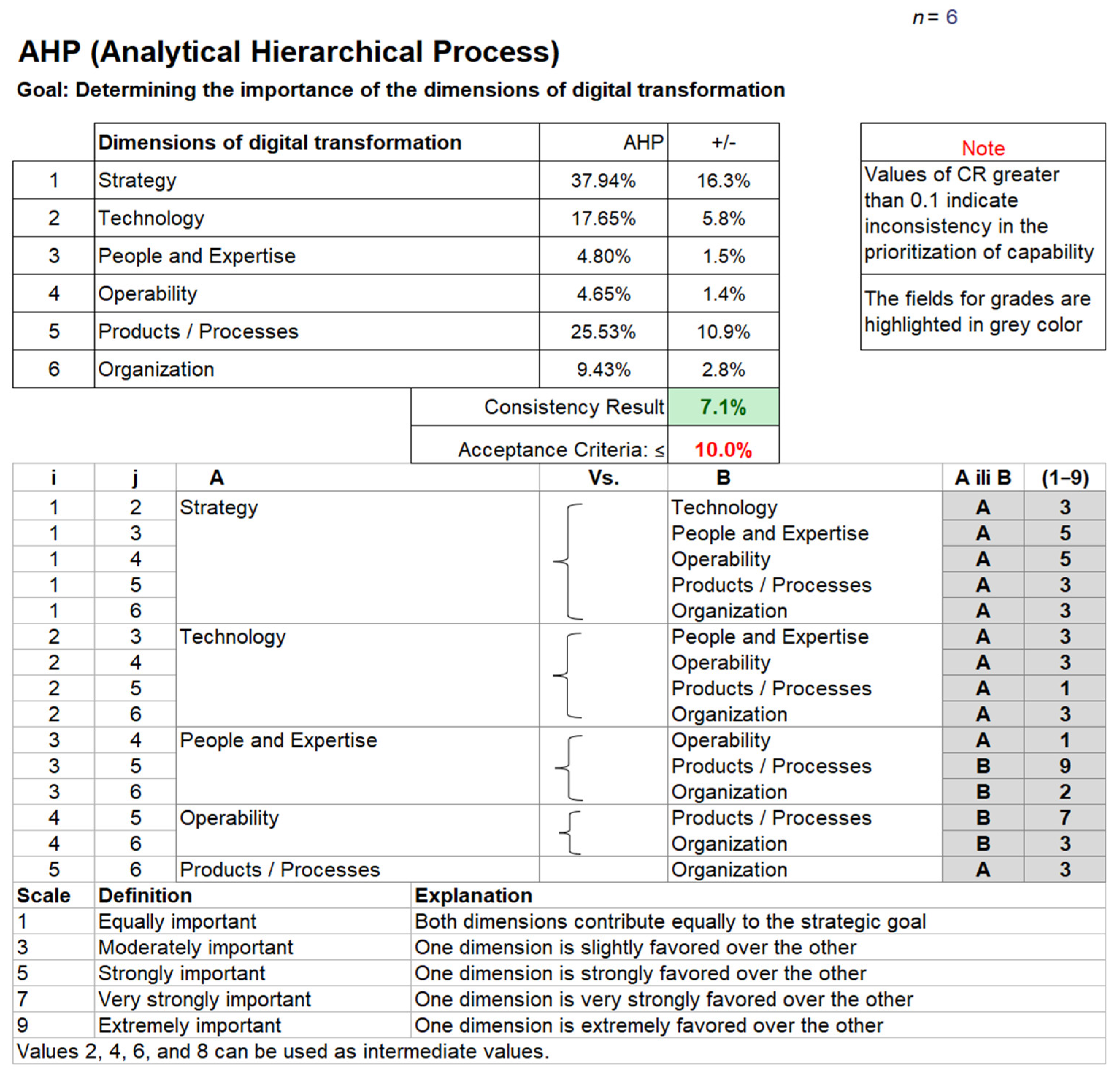
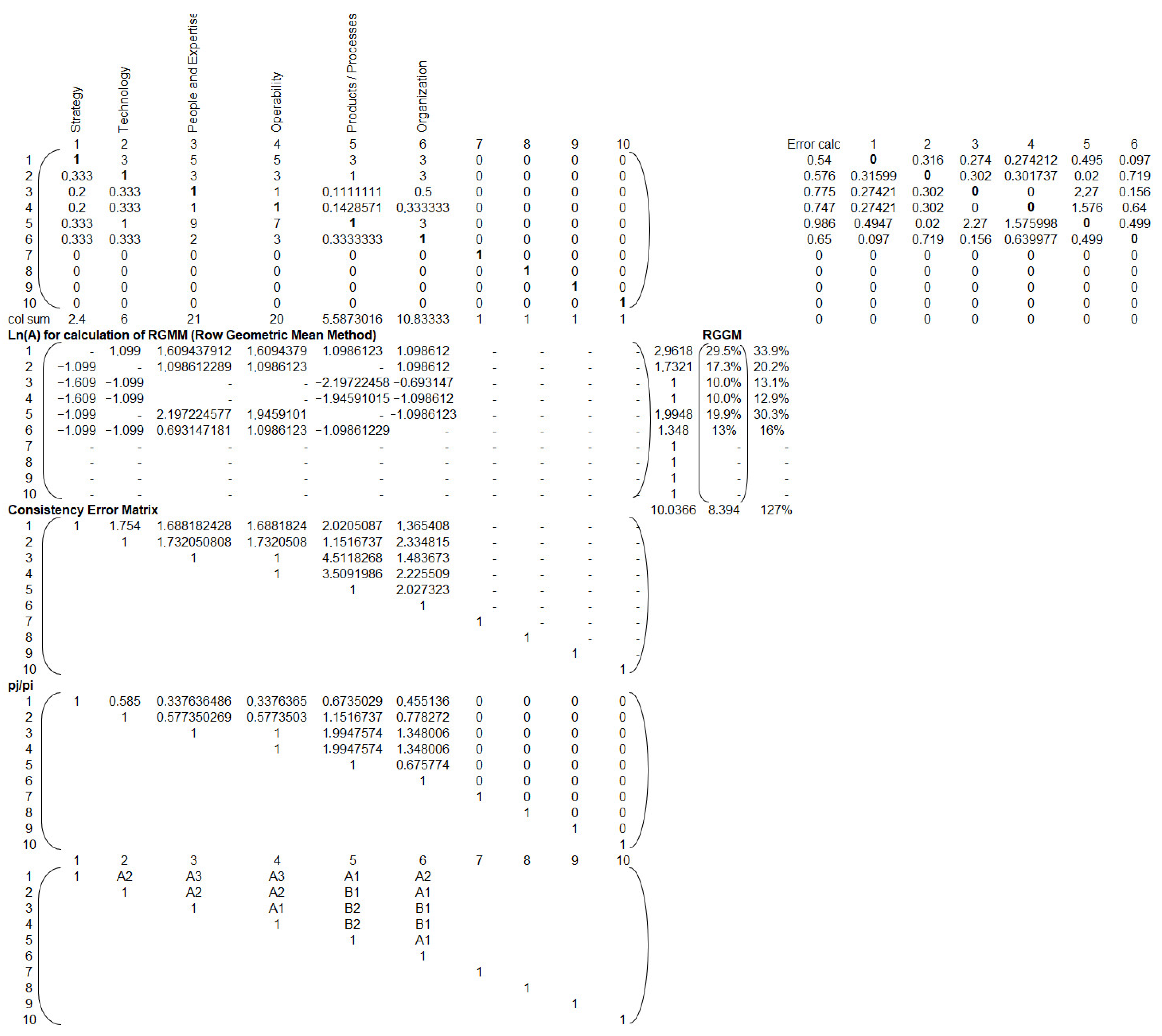
References
- Kraus, S.; Jones, P.; Kailer, N.; Weinmann, A.; Chaparro-Banegas, N.; Roig-Tierno, N. Digital Transformation: An Overview of the Current State of the Art of Research. Sage Open 2021, 11, 1–15. [Google Scholar] [CrossRef]
- Wirtz, B.W.; Weyerer, J.C.; Heckeroth, J.K. Digital Disruption and Digital Transformation: A Strategic Integrative Framework. Int. J. Innov. Manag. 2022, 26. [Google Scholar] [CrossRef]
- Åström, J.; Reim, W.; Parida, V. Value Creation and Value Capture for AI Business Model Innovation: A Three-Phase Process Framework. Rev. Manag. Sci. 2022, 16, 2111–2133. [Google Scholar] [CrossRef]
- Hess, T.; Matt, C.; Benlian, A.; Wiesböck, F. Options for Formulating a Digital Transformation Strategy. MIS Q. Exec. 2016, 15, 123–139. [Google Scholar]
- Chan, Y.E.; Krishnamurthy, R.; Sadreddin, A. Digitally-Enabled University Incubation Processes. Technovation 2022, 118. [Google Scholar] [CrossRef]
- Small and Medium Enterprises (SMEs) Finance. Available online: https://www.worldbank.org/en/topic/smefinance? (accessed on 18 April 2025).
- Di Bella, L.; Katsinis, A.; Lagüera-González, J.; Odenthal, L.; Hell, M.; Lozar, B. Annual Report on European SMEs 2022/2023: SME Performance Review 2022/2023; Publications Office of the European Union: Luxembourg, 2023; ISBN 9789268061749. [Google Scholar]
- Nimac, P.; Boroš, S.; Bašadur, A. Structural Business Indicators of Enterprises. 2020. Available online: https://podaci.dzs.hr/2022/en/29181? (accessed on 18 April 2025).
- Meyendorf, N.; Ida, N.; Singh, R.; Vrana, J. Handbook of Nondestructive Evaluation 4.0; Springer Nature: Cham, Switzerland, 2021; pp. 107–125. ISBN 978-3-30-73205-9. [Google Scholar]
- Lang, V. Digitalization and Digital Transformation. In Digital Fluency. In Digital Fluency; APress Media, LLC, Part of Springer Nature: New York, NY, USA, 2021; pp. 1–50. [Google Scholar]
- Reis, J.; Amorim, M.; Melão, N.; Cohen, Y.; Rodrigues, M. Digitalization: A Literature Review and Research Agenda. In Proceedings of the 25th International Joint Conference on Industrial Engineering and Operations Management—IJCIEOM, Novi Sad, Serbia, 15–17 July 2019; IJCIEOM 2019, Lecture Notes on Multidisciplinary Industrial Engineering; Springer: Cham, Switzerland, 2020. [Google Scholar]
- Schumacher, A.; Erol, S.; Sihn, W. A Maturity Model for Assessing Industry 4.0 Readiness and Maturity of Manufacturing Enterprises. Procedia CIRP 2016, 52, 161–166. [Google Scholar] [CrossRef]
- Wen, H.; Zhong, Q.; Lee, C.-C. Digitalization, Competition Strategy and Corporate Innovation: Evidence from Chinese Manufacturing Listed Companies. Int. Rev. Financ. Anal. 2022, 82. [Google Scholar] [CrossRef]
- Nasiri, M.; Saunila, M.; Ukko, J. Digital Orientation, Digital Maturity, and Digital Intensity: Determinants of Financial Success in Digital Transformation Settings. Int. J. Oper. Prod. Manag. 2022, 42, 274–298. [Google Scholar] [CrossRef]
- Brynjolfsson, E.; Rahman, M. Competing in the Age of Omnichannel Retailing. Available online: https://www.researchgate.net/publication/297689078_Competing_in_the_Age_of_Omnichannel_Retailing (accessed on 1 December 2024).
- Benlian, A.; Kettinger, W.J.; Sunyaev, A.; Winkler, T.J. Special Section: The Transformative Value of Cloud Computing: A Decoupling, Platformization, and Recombination Theoretical Framework. J. Manag. Inf. Syst. 2018, 35, 719–739. [Google Scholar] [CrossRef]
- Santos, S.; Gonçalves, H.M.; Teles, M. Social Media Engagement and Real-Time Marketing: Using Net-Effects and Set-Theoretic Approaches to Understand Audience and Content-Related Effects. Psychol. Mark. 2023, 40, 497–515. [Google Scholar] [CrossRef]
- Li, D.; Fast-Berglund, Å.; Paulin, D. Current and Future Industry 4.0 Capabilities for Information and Knowledge Sharing: Case of Two Swedish SMEs. Int. J. Adv. Manuf. Technol. 2019, 105, 3951–3963. [Google Scholar] [CrossRef]
- Hodapp, D.; Hanelt, A. Interoperability in the Era of Digital Innovation: An Information Systems Research Agenda. J. Inf. Technol. 2022, 37, 1–21. [Google Scholar] [CrossRef]
- Verhoef, P.C.; Broekhuizen, T.; Bart, Y.; Bhattacharya, A.; Qi Dong, J.; Fabian, N.; Haenlein, M. Digital Transformation: A Multidisciplinary Reflection and Research Agenda. J. Bus Res. 2021, 122, 889–901. [Google Scholar] [CrossRef]
- Grufman, N.; Lyons, S. Exploring Industry 4.0 A Readiness Assessment for SMEs; Stockholm University: Stockholm, Sweden, 2020. [Google Scholar]
- Schoemaker, P.J.; Heaton, S.; Teece, D. Innovation, Dynamic Capabilities, and Leadership. Calif. Manag. Rev. 2018, 61, 15–42. [Google Scholar] [CrossRef]
- Westerman, G.; Bonnet, D.; McAfee, A. Leading Digital: Turning Technology into Business Transformation; Harvard Business Review Press: Boston, MA, USA, 2014; Volume 61, ISBN 978-1-62527-247-8. [Google Scholar]
- Nambisan, S.; Wright, M.; Feldman, M. The Digital Transformation of Innovation and Entrepreneurship: Progress, Challenges and Key Themes. Res. Policy 2019, 48. [Google Scholar] [CrossRef]
- Hanelt, A.; Bohnsack, R.; Marz, D.; Antunes Marante, C. A Systematic Review of the Literature on Digital Transformation: Insights and Implications for Strategy and Organizational Change. J. Manag. Stud. 2021, 58, 1159–1197. [Google Scholar] [CrossRef]
- Marcos, S.; Reis, J.L.; Pereira, R.H. Digital Maturity Model for Industries SMEs: A Systematic Digital Maturity Model for Industries SMEs: A Systematic Literature Review. In Proceedings of the CAPSI 2024 Proceedings Portugal (CAPSI), Porto, Portugal, 3–5 October 2024; AIS Electronic Library (AISeL): Atlanta, GA, USA, 2024; pp. 41–55. [Google Scholar]
- Krulčić, E.; Doboviček, S.; Pavletić, D.; Čabrijan, I. A MCDA Based Model for Assessing Digital Maturity in Manufacturing SMEs. Teh. Glas. 2025, 19, 37–42. [Google Scholar] [CrossRef]
- European Commision Digital Economy and Society Index (DESI). Available online: https://digital-strategy.ec.europa.eu/en/library/digital-economy-and-society-index-desi-2021 (accessed on 2 March 2025).
- Telecommunication Union, I. Measuring Digital Development—Facts and Figures 2021. Available online: https://www.itu.int/en/ITU-D/Statistics/Documents/facts/FactsFigures2021.pdf (accessed on 15 January 2025).
- Dell Technologies Digital Transformation Index 2020 Executive Summary. Available online: https://www.dell.com/en-us/dt/perspectives/digital-transformation-index.htm (accessed on 2 March 2025).
- Georgescu, I.; Kinnunen, J. The Digital Effectiveness on Economic Inequality: A Computational Approach. In Proceedings of the Springer Proceedings in Business and Economics (SPBE), Online, 11–12 June 2020; Springer International Publishing: Cham, Switzerland, 2021. [Google Scholar]
- Chanias, S.; Hess, T. How Digital Are We? Maturity Models for the Assessment of a Company’s Status in the Digital Transformation. Manag. Rep. 2016, 1–14. [Google Scholar]
- Rogers, D.; de Pablo, S. Digital Maturity Model. Available online: https://www2.deloitte.com/insights/us/en/focus/digital-maturity (accessed on 6 March 2025).
- Schuh, G.; Anderl, R.; Dumitrescu, R.; Krüger, A.; Ten Hompel, M. Using the Industrie 4.0 Maturity Index in Industry. Available online: https://en.acatech.de/publication/using-the-industrie-4-0-maturity-index-in-industry-case-studies/ (accessed on 10 March 2025).
- Kane, G.C.; Palmer, D.; Phillips, A.N.; Kiron, D.; Buckley, N. Strategy, Not Technology, Drives Digital Transformation. Available online: https://sloanreview.mit.edu/projects/strategy-drives-digital-transformation/ (accessed on 11 March 2025).
- Fitzgerald, M.; Kruschwitz, N.; Bonnet, D.; Welch, M. Embracing Digital Technology, A New Strategic Imperative. Available online: https://sloanreview.mit.edu/projects/embracing-digital-technology/ (accessed on 12 March 2025).
- Valdez-De-Leon, O. A Digital Maturity Model for Telecommunications Service Providers. Available online: www.timreview.ca (accessed on 15 March 2025).
- Ochoa-Urrego, R.L.; Peña-Reyes, J.I. Digital Maturity Models: A Systematic Literature Review. In Digitalization; Schallmo, D.R.A., Tidd, J., Eds.; Springer: Cham, Switzerland, 2021; pp. 71–85. [Google Scholar]
- Rossmann, A. Digital Maturity: Conceptualization and Measurement Model. In Proceedings of the 39th International Conference on Information Systems, ICIS 2018, San Francisco, CA, USA, 13–16 December 2019. [Google Scholar]
- De Carolis, A.; Macchi, M.; Negri, E.; Terzi, S. A Maturity Model for Assessing the Digital Readiness of Manufacturing Companies. In Proceedings of the IFIP Advances in Information and Communication Technology; Springer New York LLC: New York, NY, USA, 2017; Volume 513, pp. 13–20. [Google Scholar]
- Haryanti, T.; Rakhmawati, N.A.; Subriadi, A.P. The Extended Digital Maturity Model. Big Data Cogn. Comput. 2023, 7, 17. [Google Scholar] [CrossRef]
- Thordsen, T.; Bick, M. A Decade of Digital Maturity Models: Much Ado about Nothing? Inf. Syst. E-Bus. Manag. 2023, 21, 947–976. [Google Scholar] [CrossRef]
- Kruljac, Ž. Modeli Digitalne Zrelosti Poduzeća-Objašnjenje, Pregled Literature i Analiza. Obraz. Poduzet. E4E Znan. Stručni Čas. Obraz. Poduzet. 2019, 9, 72–83. [Google Scholar]
- De Bruin, T.; Freeze, R.; Kulkarni, U.; Rosemann, M. Understanding the Main Phases of Developing a Maturity Assessment Model. In Proceedings of the ACIS 2005 Proceedings: 16th Australian Conference on Information Systems, Sydney, Australia, 29 November 2005. [Google Scholar]
- Axmann, B.; Harmoko, H. Industry 4.0 Readiness Assessment. Teh. Glas. 2020, 14, 212–217. [Google Scholar] [CrossRef]
- Hizam-Hanafiah, M.; Soomro, M.A.; Abdullah, N.L. Industry 4.0 Readiness Models: A Systematic Literature Review of Model Dimensions. Information 2020, 11, 364. [Google Scholar] [CrossRef]
- Gökalp, E.; Martinez, V. Digital Transformation Capability Maturity Model Enabling the Assessment of Industrial Manufacturers. Comput. Ind. 2021, 132, 103522. [Google Scholar] [CrossRef]
- Elhusseiny, H.M.; Crispim, J. A Review of Industry 4.0 Maturity Models: Adoption of SMEs in the Manufacturing and Logistics Sectors. Procedia Comput. Sci. 2023, 219, 236–243. [Google Scholar] [CrossRef]
- EBD Core Development Team. The Smart Industry Readiness Index Catalysing the Transformation of Manufacturing. The Smart Industry Readiness Framework. The LEAD Framework. Available online: www.edb.gov.sg (accessed on 15 February 2025).
- Gill, M.; Vanboskirk, S. The Digital Maturity Model 4.0 Benchmarks: Digital Business Transformation Playbook. Available online: http://forrester.nitro-digital.com/pdf/Forrester-s%20Digital%20Maturity%20Model%204.0.pdf (accessed on 6 March 2025).
- Geissbauer, R.; Vedso, J.; Schrauf, S. 2016 Global Industry 4.0 Survey Industry 4.0: Building the Digital Enterprise. Available online: www.pwc.com/industry40 (accessed on 21 February 2025).
- Spaltini, M.; Acerbi, F.; Pinzone, M.; Gusmeroli, S.; Taisch, M. Defining the Roadmap towards Industry 4.0: The 6Ps Maturity Model for Manufacturing SMEs. Procedia CIRP 2022, 105, 631–636. [Google Scholar] [CrossRef]
- Omol, E.J.; Mburu, L.W.; Abuonji, P.A. Digital Maturity Assessment Model (DMAM): Assimilation of Design Science Research (DSR) and Capability Maturity Model Integration (CMMI). Digit. Transform. Soc. 2024, 4, 128–152. [Google Scholar] [CrossRef]
- Tubis, A.A. Digital Maturity Assessment Model for the Organizational and Process Dimensions. Sustainability 2023, 15, 5122. [Google Scholar] [CrossRef]
- Kalender, Z.T.; Žilka, M. A Comparative Analysis of Digital Maturity Models to Determine Future Steps in the Way of Digital Transformation. Procedia Comput. Sci. 2024, 232, 903–912. [Google Scholar] [CrossRef]
- Ustundag, A.; Cevikcan, E. Industry 4.0: Managing The Digital Transformation; Springer Series in Advanced Manufacturing; Springer International Publishing: Cham, Switzerland, 2018; ISBN 978-3-319-57869-9. [Google Scholar]
- Martinčević, N.Ć.; Salihić, A.; Novoselec, S.M.; Parić, A.; Jakopović, F.; Galijan, V.; Sandalić, D.; Nahić, E.; Perić, M.; Mikulaš, D.; et al. Digitalna Transformacija u Hrvatskoj. Available online: www.apsolon.com (accessed on 25 March 2025).
- Mladineo, M.; Celent, L.; Milković, V.; Veža, I. Current State Analysis of Croatian Manufacturing Industry with Regard to Industry 4.0/5.0. Machines 2024, 12, 87. [Google Scholar] [CrossRef]
- Palčić, I.; Buchmeister, B.; Ojsteršek, R.; Kovič, K. Manufacturing Company Industry 4.0 Readiness: Case from Slovenia, Croatia and Serbia; Academy of Sciences and Arts of Bosnia and Herzegovina: Sarajevo, Bosnia and Herzegovina, 2022; pp. 25–34. [Google Scholar]
- Palcic, I.; Ojstersek, R.; Buchmeister, B.; Kovic, K. Industry 4.0 Readiness of Slovenian Manufacturing Companies. In DAAAM International Scientific Book; Katalinic, E., Ed.; DAAAM International: Vienna, Austria, 2022; pp. 001–016. ISBN 978-3-902734-34-1. [Google Scholar]
- Trstenjak, M.; Opetuk, T.; Pavković, D.; Zorc, D. Industry 4.0 in Croatia–Perspective and Industrial Familiarity with the (New) Digital Concept. In Proceedings of the International Conference on the Industry 4.0 Model for Advanced Manufacturing; Wang, L., Majstorovic, V.D., Mourtzis, D., Carpanzano, E., Moroni, G., Galantucci, L.M., Eds.; Springer International Publishing: Cham, Switzerland, 2020. [Google Scholar]
- Bajrić, H.; Vučijak, B.; Kadrić, E.; Anđelić, A. Benchmarking of Bosnia and Herzegovina to Croatia Manufacturing Industry and Industry 4.0. TEM J. 2021, 10, 1064–1071. [Google Scholar] [CrossRef]
- Gavrić, T.; Cosic, M. Challenges of The Fourth Industrial Revolution: A Case Study of Bosnia and Herzegovina. Int. J. Sales Retail. Mark. 2021, 10, 51–60. [Google Scholar]
- Rakic, S.; Pavlovic, M.; Marjanovic, U. A Precondition of Sustainability: Industry 4.0 Readiness. Sustainability 2021, 13, 6641. [Google Scholar] [CrossRef]
- Joković, J. Primena Koncepta Industrija 4.0 u Republici Srbiji. Zb. Rad. Fak. Teh. Nauka Novom Sadu 2020, 35, 1782–1785. [Google Scholar] [CrossRef]
- Aras, A.; Büyüközkan, G. Digital Transformation Journey Guidance: A Holistic Digital Maturity Model Based on a Systematic Literature Review. Systems 2023, 11, 213. [Google Scholar] [CrossRef]
- Lichtblau, K.; Stich, V.; Bertenrath, R.; Blum, M.; Bleider, M.; Millack, A.; Schmitt, K.; Schmitz, E.; Schröter, M. Industrie 4.0 Readiness. Available online: https://www.vdma.org/en-GB/viewer/-/v2article/render/1084566 (accessed on 7 March 2025).
- Saaty, T.L. The Analitic Hierarchy Process; McGraw-Hill: New York, NY, USA, 1980; Volume 324. [Google Scholar]
- Krulčić, E.; Pavletić, D.; Doboviček, S.; Žic, S. Multi-Criteria Model for the Selection of New Process Equipment in Casting Manufacturing: A Case Study. Teh. Glas. 2022, 16, 170–177. [Google Scholar] [CrossRef]
- Goepel, K.D. Implementing the Analytic Hierarchy Process as a Standard Method for Multi-Criteria Decision Making in Corporate Enterprises—A New AHP Excel Template with Multiple Inputs. In Proceedings of the International Symposium on the Analytic Hierarchy Process, Kuala Lumpur, Malaysia, 23–26 June 2013. [Google Scholar]
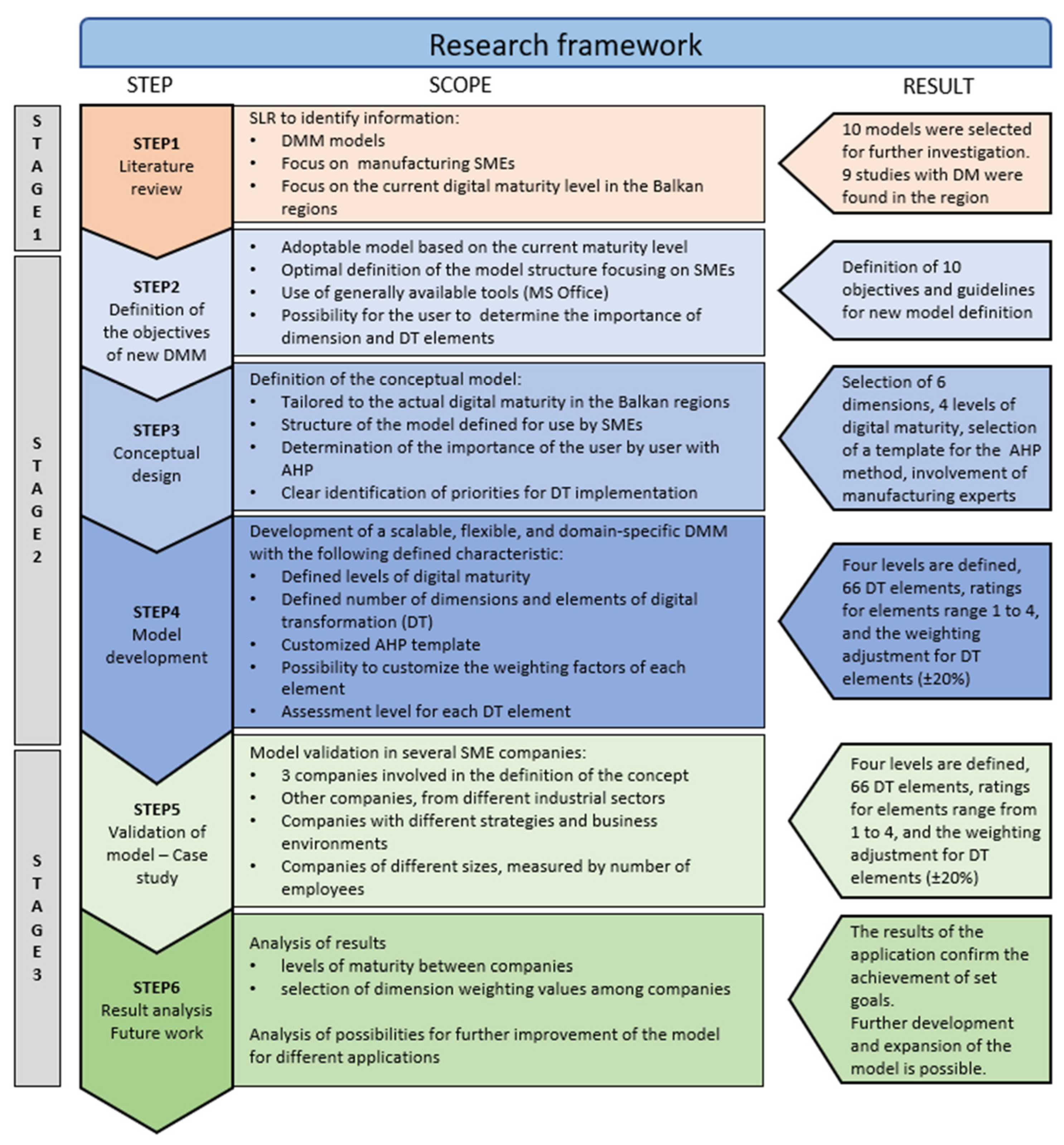
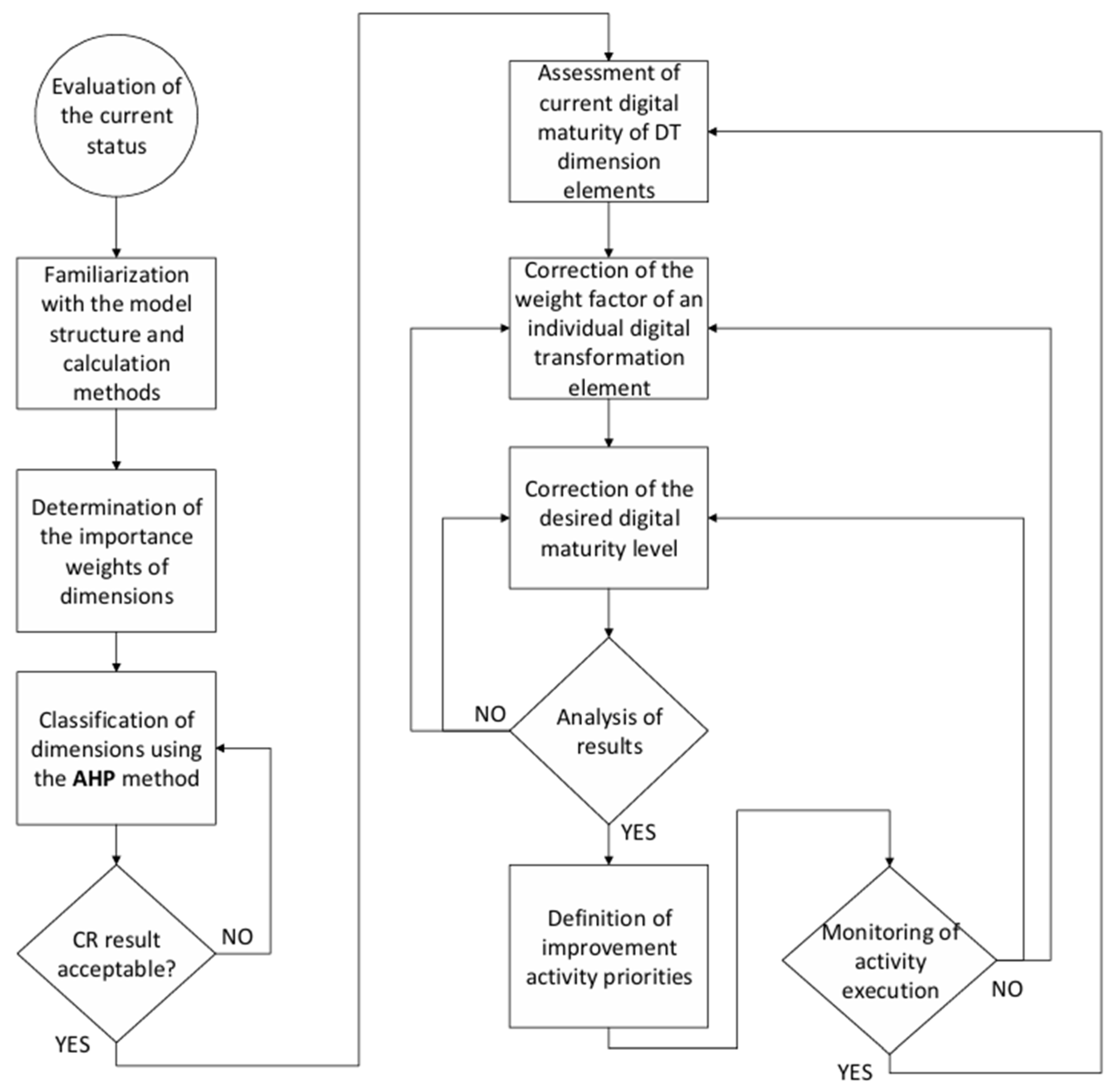
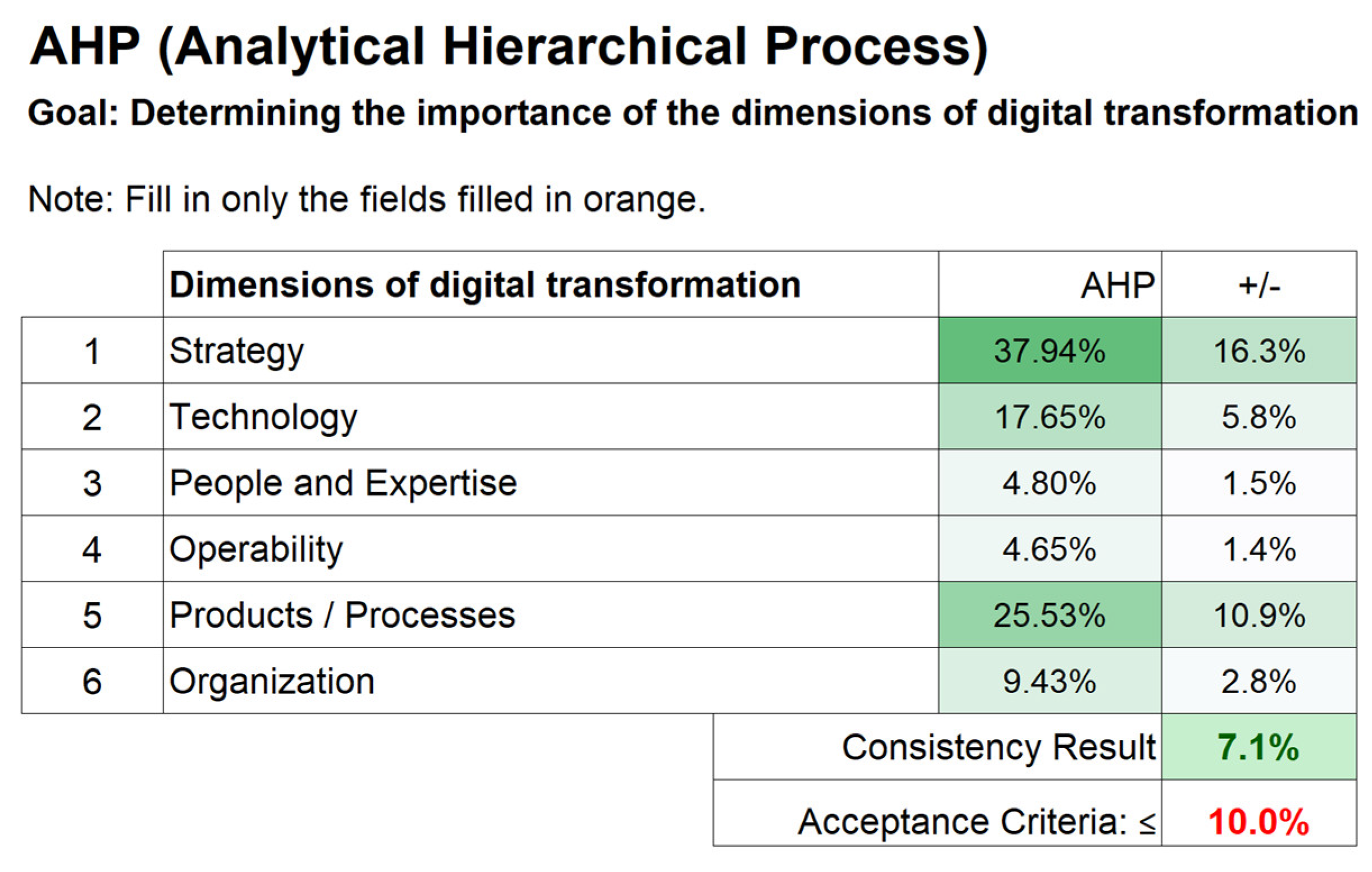
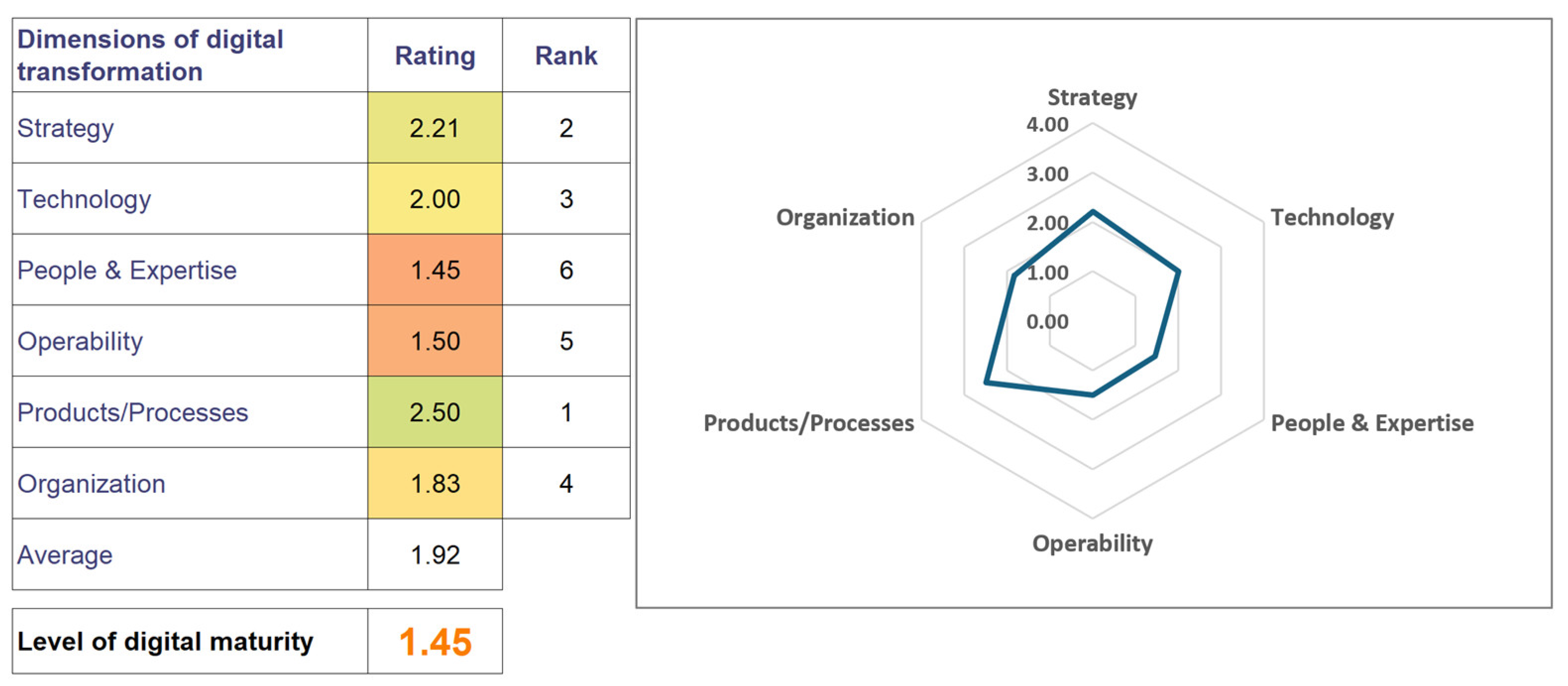

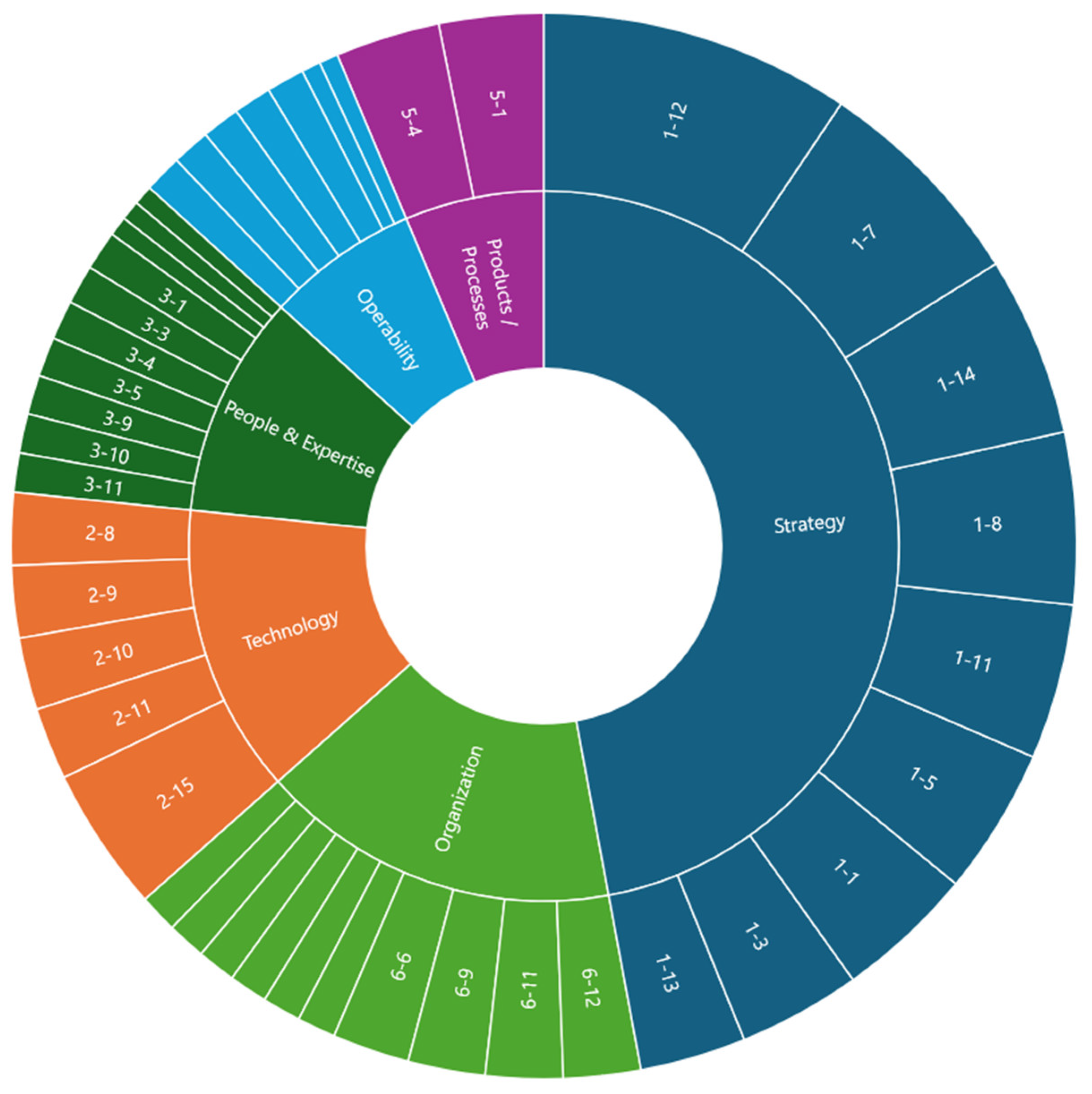

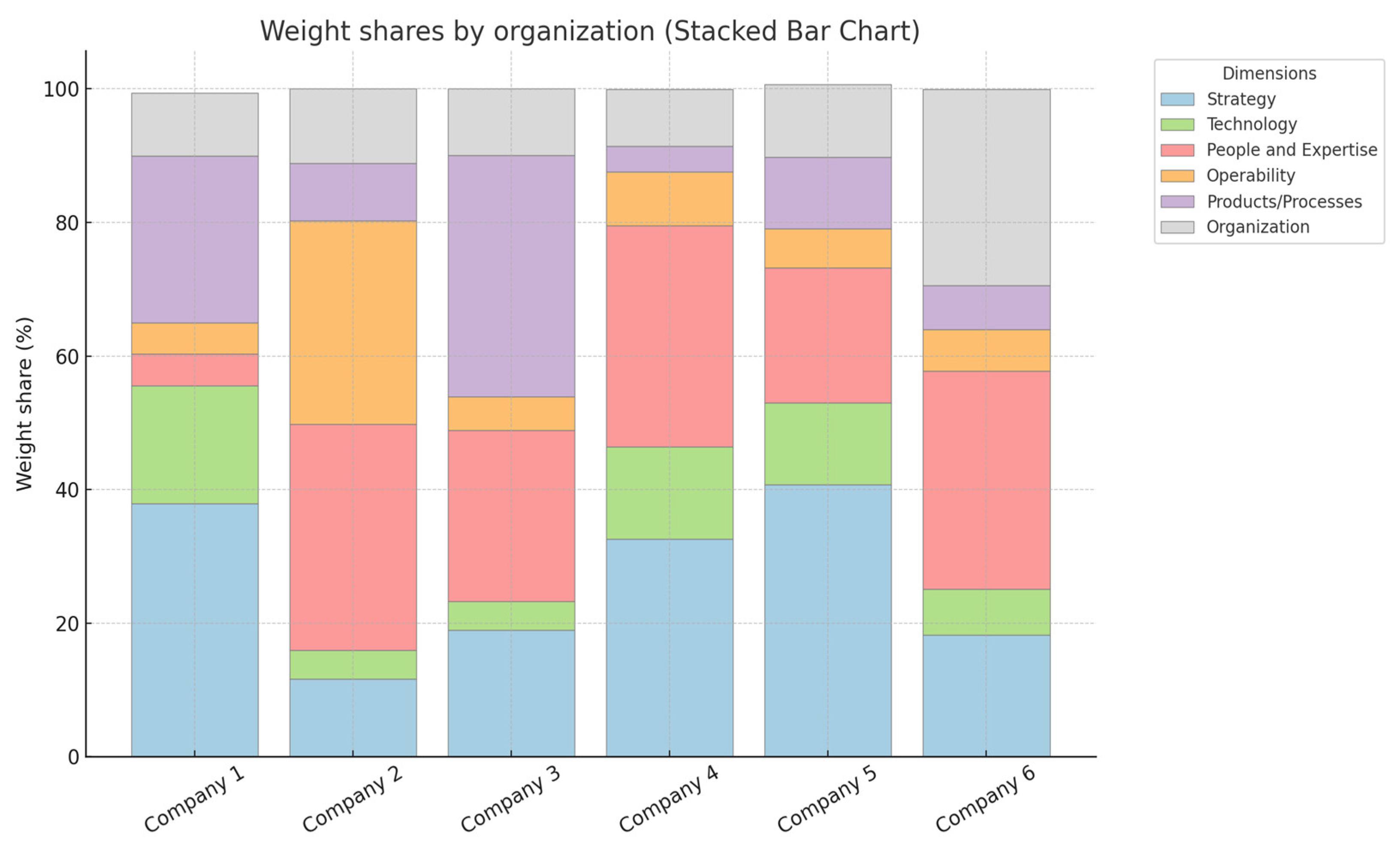
| Maturity Level | Description |
|---|---|
| The company has no or only a minimal strategy for DT. Digitalization activities are carried out on an ad hoc basis, without a clear structure or alignment with the company’s goals. This phase is characterized by a lack of planning, informal processes, and limited or non-existent digital resources. |
| Fundamental digital initiatives are underway. There is an organizational interest in digitalization, but the activities are not yet fully integrated into the corporate strategy. In this phase, there are initial digital strategies, isolated projects, and a low level of digital competence among employees. |
| There are structured digital initiatives with clear strategies for the introduction of technology. Business processes and digital tools are gradually integrated, supported by clearly defined digitalization goals and targeted investments in technology. Formal processes are in place for the development of digital capabilities, and the company aligns its digital strategies with overall business objectives, creating a solid foundation for the further development of DT. |
| Digital strategies and technologies are fully integrated into the business processes. The company uses data and technology to optimize business performance. Leadership plays a central role in driving DT, which is characterized by a high degree of technology integration, extensive use of analytics and data-driven decisions, and a robust digital infrastructure to support business processes. |
| Given the current average maturity level of SMEs and the significant gap between existing capabilities and the skills required for advanced Industry 4.0 maturity, this stage is intentionally omitted at this stage. |
| Model or Document | Maturity Levels/Dimensions | Calculation Method | Definition of Weighting Factors | Clarity in Determining Weighting Factors | Comparative Differences |
|---|---|---|---|---|---|
| Acatech Industrie 4.0 [67] | 6/4 | Questionnaire with averaging by dimensions | No explicit weighting factors | Not clearly defined | Equal weighting of dimensions without adjustment to corporate strategy. |
| Schumacher et al. [12] | 5/9 | Likert scale + weighted average | Expert interviews | Clearly defined | High complexity (62 criteria). Not customizable for different companies. |
| Rossmann model [39] | 0/8 | Multi-criteria analysis | No weighting factors | Not defined | Limited flexibility for SMEs. |
| PwC “Industry 4.0” [51] | 4/7 | Self-assessment | Strategic goals | Subjective | Subjective self-assessment without mathematical validation. |
| IMPULS/VDMA [44] | 6/6 | Questionnaire with weighted average | Company surveys | Clearly defined | Exclusively focused on the German market. |
| Ustundag and Cevikcan [56] | 5/6 | Questionnaire with flexible weighting | Customizable by sector | Not strictly defined | Unclear definition of weighting factors. |
| DAMA-AHP | 4/6 | AHP + customizable weightings and gap analysis | User-defined priorities (AHP + correction factors) | Very clear (AHP methodology) | Adaptable for industrial SMEs, dynamic planning, and multidimensional prioritization. |
| Ranking of Measures by Element | Element of the Digital Transformation Dimension | Dimension | Label |
|---|---|---|---|
| 1 | The current business model was evaluated and supplemented by digitalization activities. | Strategy | 1-12 |
| 2 | The need for digitalization was determined and aligned with the company’s goals. | Strategy | 1-7 |
| 3 | Indicators are used to monitor the implementation status of the digitalization strategy. | Strategy | 1-14 |
| 4 | Funding has been made available to support digitization for at least one year | Strategy | 1-8 |
| 5 | The company’s management is prepared to make the necessary organizational changes for the purpose of digitalization. The management is prepared to make the necessary organizational changes for the purpose of DT. | Strategy | 1-11 |
| 6 | Investments in digitalization have been made or are planned in administration and human resources. | Strategy | 1-5 |
| 7 | Technologies for big data analysis and decision support systems are used. | Technology | 2-15 |
| 8 | Investments in digitalization have been made or are planned in the design of products/processes/services (including research, development, and innovation). | Strategy | 1-1 |
| 9 | Investments in digitalization are made or planned in production processes (production, packaging, maintenance, services, etc.) | Strategy | 1-3 |
| 10 | The company works with customers, suppliers, and/or academia to implement digitalization projects. | Strategy | 1-13 |
| Company | Description of Sector | Nb. of Employees | Digital Foundation | Use of Digital Tools or Technologies |
|---|---|---|---|---|
| Company C1 | Sales and maintenance of marine engines | 11 | Basic digital programs for the operations of the company | CRM portal MRPII GoSoft software |
| Company C2 | Maintenance of road transport vehicles for passenger transport | 110 | Basic digital programs for the operations of the company | MRPII Venio software |
| Company C3 | Metalworking and manufacture of metalworking machinery | 35 | Basic digital programs for the operations of the company | MRPII Pauk software |
| Company C4 | Manufacture of automotive parts | 205 | Good foundation and understanding of DT for further implementation of digital technologies | Horizontal and vertical system integration (ERP, MES); cloud, cybersecurity IoT, simulations |
| Company C5 | Metal processing: production of protective devices for various work machines | 140 | Good foundation and understanding of DT for further implementation of digital technologies | Horizontal and vertical system integration (ERP, MES); IoT |
| Company C6 | Glass industry | 240 | Good foundation and understanding of DT for further implementation of digital technologies | Horizontal and vertical system integration (ERP); IoT |
| Maturity Dimensions | C1 | C2 | C3 | C4 | C5 | C6 | Avg | Std | R |
|---|---|---|---|---|---|---|---|---|---|
| Strategy | 2.21 | 2.07 | 1.79 | 2.07 | 2.67 | 2.40 | 2.20 | 0.30 | 0.88 |
| Technology | 2.00 | 1.30 | 1.73 | 2.16 | 1.89 | 2.00 | 1.85 | 0.30 | 0.86 |
| People and Expertise | 1.45 | 1.35 | 1.44 | 1.85 | 2.54 | 2.70 | 1.89 | 0.59 | 1.35 |
| Operability | 1.50 | 1.78 | 1.50 | 2.22 | 2.30 | 2.00 | 1.88 | 0.35 | 0.80 |
| Products/Processes | 2.50 | 3.00 | 2.00 | 2.40 | 1.83 | 2.80 | 2.42 | 0.45 | 1.17 |
| Organization | 2.00 | 1.50 | 1.67 | 1.86 | 2.29 | 3.30 | 2.10 | 0.65 | 1.80 |
| Std | 0.37 | 0.58 | 0.19 | 0.20 | 0.31 | 0.46 | 0.35 | 0.16 | 0.40 |
| Average value | 1.94 | 1.83 | 1.69 | 2.09 | 2.25 | 2.55 | 2.06 | 0.31 | 0.86 |
| Level of digital maturity * | 1.45 | 1.30 | 1.44 | 1.85 | 1.83 | 2.00 | 1.65 | 0.28 | 0.70 |
| Maturity Dimensions | C1 | C2 | C3 | C4 | C5 | C6 | Avg | Std | R |
|---|---|---|---|---|---|---|---|---|---|
| Strategy | 37.90 | 11.62 | 18.95 | 32.60 | 40.70 | 18.20 | 26.66 | 11.97 | 29.08 |
| Technology | 17.65 | 4.32 | 4.35 | 13.80 | 12.30 | 6.90 | 9.89 | 5.51 | 13.33 |
| People and Expertise | 4.80 | 33.84 | 25.54 | 33.10 | 20.20 | 32.70 | 25.03 | 11.26 | 29.04 |
| Operability | 4.65 | 30.45 | 5.06 | 8.10 | 5.90 | 6.20 | 10.06 | 10.06 | 25.80 |
| Products/Processes | 25.00 | 8.68 | 36.18 | 3.80 | 10.70 | 6.60 | 15.16 | 12.67 | 32.38 |
| Organization | 9.43 | 11.09 | 9.91 | 8.50 | 10.90 | 29.30 | 13.19 | 7.95 | 20.80 |
Disclaimer/Publisher’s Note: The statements, opinions and data contained in all publications are solely those of the individual author(s) and contributor(s) and not of MDPI and/or the editor(s). MDPI and/or the editor(s) disclaim responsibility for any injury to people or property resulting from any ideas, methods, instructions or products referred to in the content. |
© 2025 by the authors. Licensee MDPI, Basel, Switzerland. This article is an open access article distributed under the terms and conditions of the Creative Commons Attribution (CC BY) license (https://creativecommons.org/licenses/by/4.0/).
Share and Cite
Krulčić, E.; Doboviček, S.; Pavletić, D.; Čabrijan, I. A Dynamic Assessment of Digital Maturity in Industrial SMEs: An Adaptive AHP-Based Digital Maturity Model (DMM)with Customizable Weighting and Multidimensional Classification (DAMA-AHP). Technologies 2025, 13, 282. https://doi.org/10.3390/technologies13070282
Krulčić E, Doboviček S, Pavletić D, Čabrijan I. A Dynamic Assessment of Digital Maturity in Industrial SMEs: An Adaptive AHP-Based Digital Maturity Model (DMM)with Customizable Weighting and Multidimensional Classification (DAMA-AHP). Technologies. 2025; 13(7):282. https://doi.org/10.3390/technologies13070282
Chicago/Turabian StyleKrulčić, Elvis, Sandro Doboviček, Duško Pavletić, and Ivana Čabrijan. 2025. "A Dynamic Assessment of Digital Maturity in Industrial SMEs: An Adaptive AHP-Based Digital Maturity Model (DMM)with Customizable Weighting and Multidimensional Classification (DAMA-AHP)" Technologies 13, no. 7: 282. https://doi.org/10.3390/technologies13070282
APA StyleKrulčić, E., Doboviček, S., Pavletić, D., & Čabrijan, I. (2025). A Dynamic Assessment of Digital Maturity in Industrial SMEs: An Adaptive AHP-Based Digital Maturity Model (DMM)with Customizable Weighting and Multidimensional Classification (DAMA-AHP). Technologies, 13(7), 282. https://doi.org/10.3390/technologies13070282








